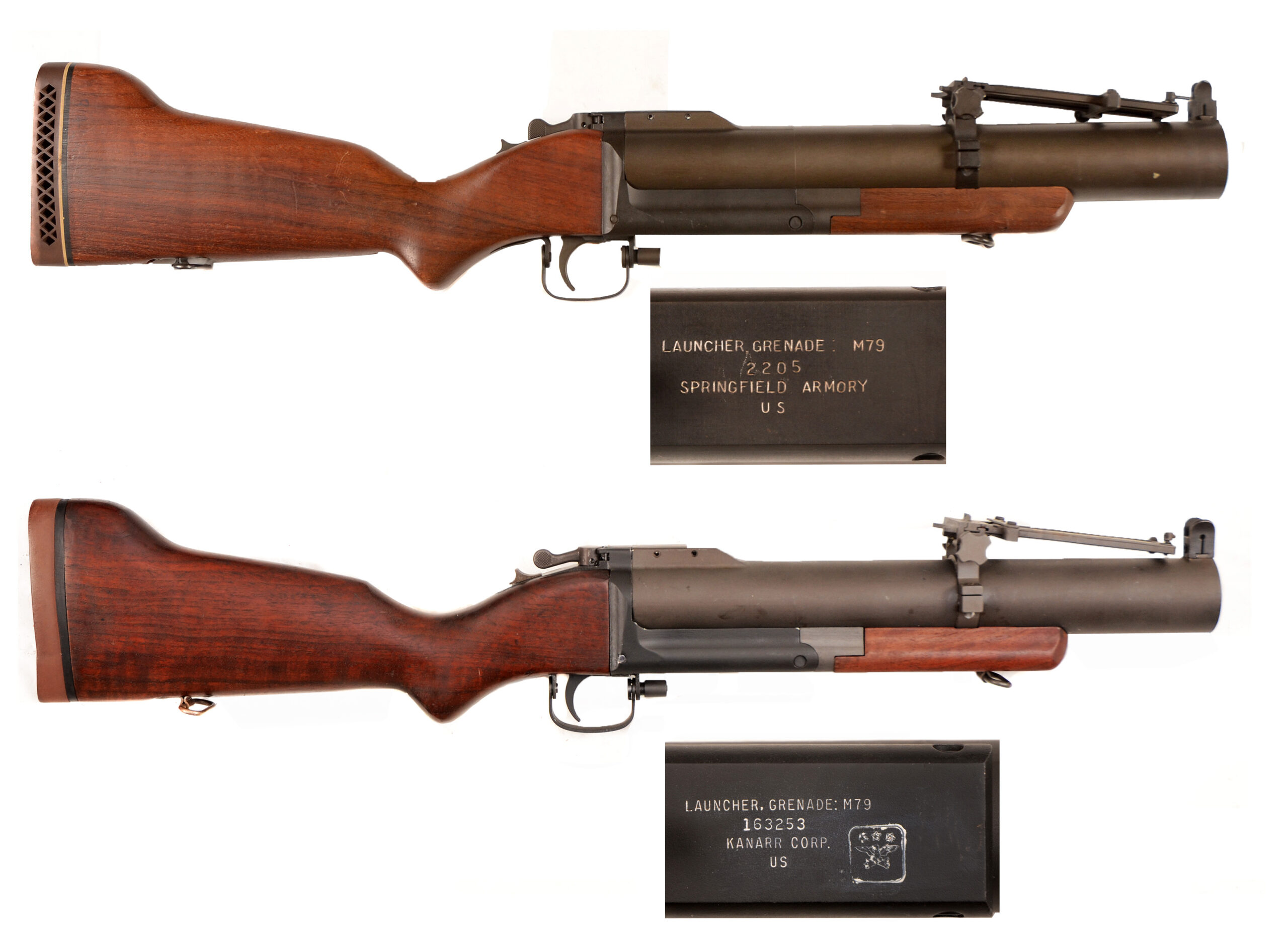By Frank Iannamico
During World War II, the basic weapons of the U.S. infantryman were the rifle, light machine gun and fragmentation grenades. Hand and rifle grenades were used for short-range area targets. Hand-thrown grenades have a realistic range of 30 to 50 yards. The maximum range of rifle-launched grenades was approximately 100 yards; both were ill-suited for engaging targets with accurate indirect fire. Light mortars were used for ranges from 300 to 900 yards. The same weapons and limitations were fielded during the Korean Conflict by U.S. infantryman.
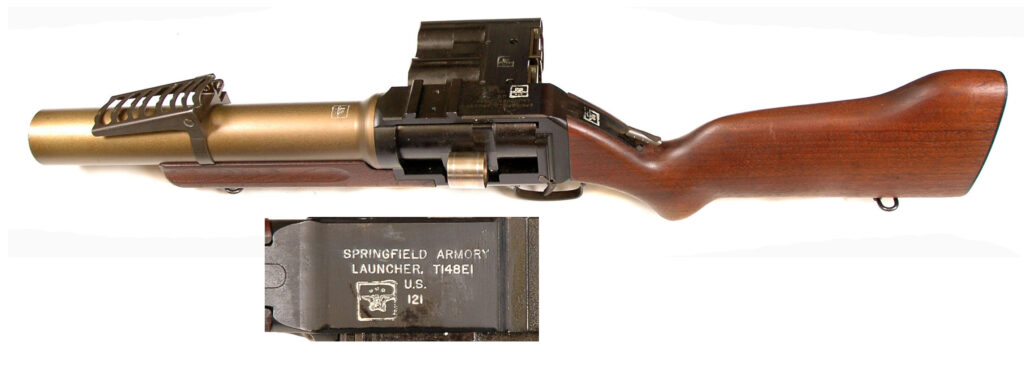
The Rifle Grenade Launcher
During the late 1950s, the M7A3 grenade launcher adapter was being issued for use on the M1 rifle. After the M14 rifle replaced the M1, the M76 grenade launcher was adopted. For accuracy, the M15 tilting-bar sight, designed to be attached to the M14 rifle’s stock, was issued for use with the M76 launcher. Special “grenade launching cartridges” were used. Rifle grenades could also be launched from the M16 rifle, but no special adapter was needed; grenades could be slipped over the NATO standard 22mm diameter flash suppressor. Disadvantages of launching grenades from rifle barrels included: short range, inaccuracy and heavy recoil that would sometimes break buttstocks.
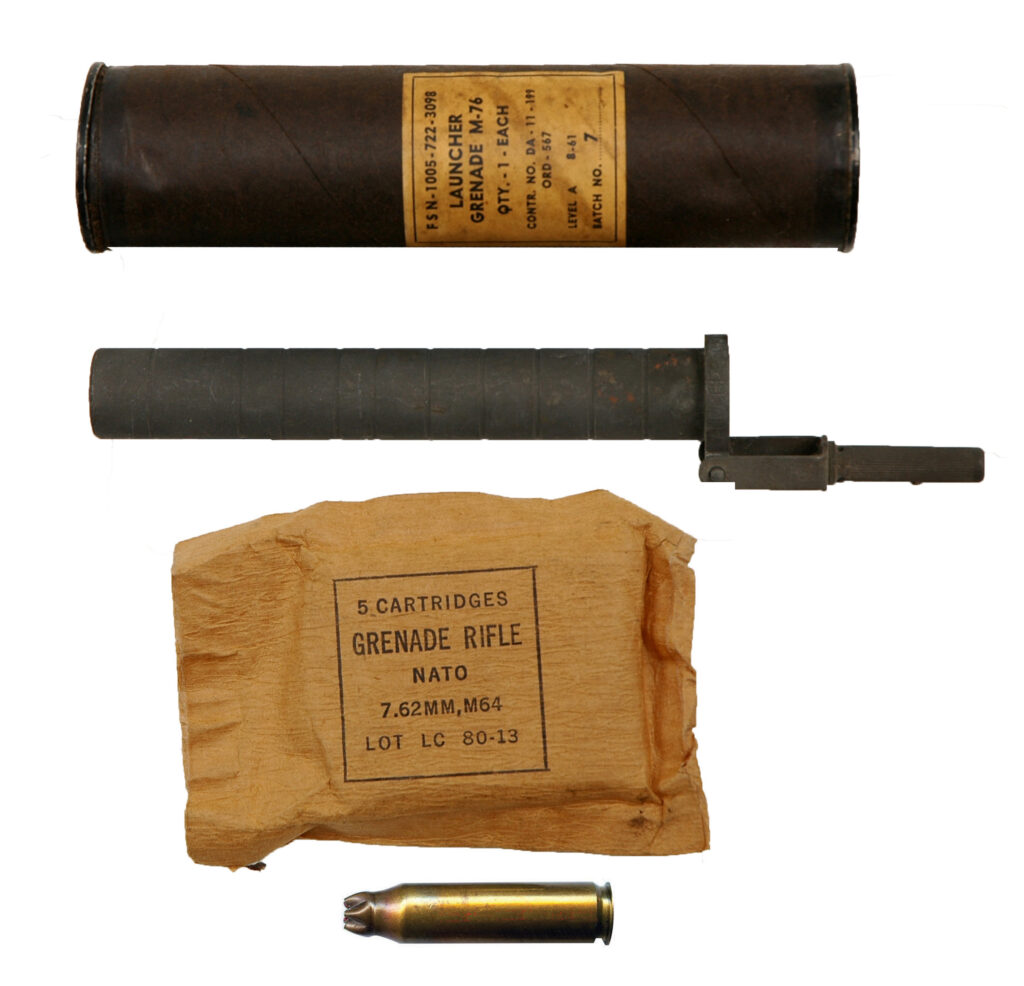
Clearly, a new weapon was needed, one that could provide accurate direct and indirect fire to fill the gap between the rifle, hand grenades and the light mortar. During the 1950s the United States Ordnance Department began development of a weapon that could fire high explosive munitions, multiple projectile anti-personnel rounds and smoke and illumination rounds.
40mm Ammunition
During the early 1950s the Ballistic Research Laboratories at the Aberdeen Proving Ground developed a 40mm high-explosive, fragmentation projectile. The goal was a range of 400 meters at the relatively low velocity of 250 feet per second, with a recoil force no more than that of a 12-gauge shotgun. The new projectile used a high-low pressure system, which was developed by the German firm of Rheinmetall-Borsig during World War II for their 8cm 8H63 anti-tank gun. The advantage of the high-low system was that a lightweight barrel could be used, reducing the overall weight of the weapon.
The M79 Grenade Launcher
The concept of a lightweight weapon capable of projecting a grenade further than could be thrown by hand and could exceed the range of rifle-launched grenades was coordinated by the Small Arms Development Branch, headed by Colonel Studler. Jack Bird, a deputy to Colonel Studler, took an interest in the project; he built a crude launcher and brought it to the Pentagon to demonstrate. The device was comprised of a short length of tubing with the same inside diameter as a golf ball. To operate the “launcher,” a golf ball would be placed inside the tube and compressed against a spring. The golf ball was secured in place with a nail. Upon removing the nail, the golf ball would be launched. Bird, an avid golfer, suggested the name “Project Niblick” after the number nine iron, a high lofting golf club.

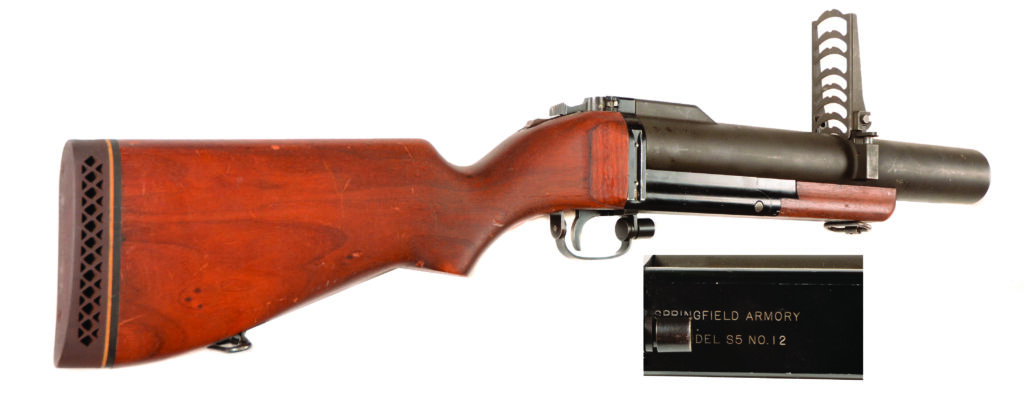
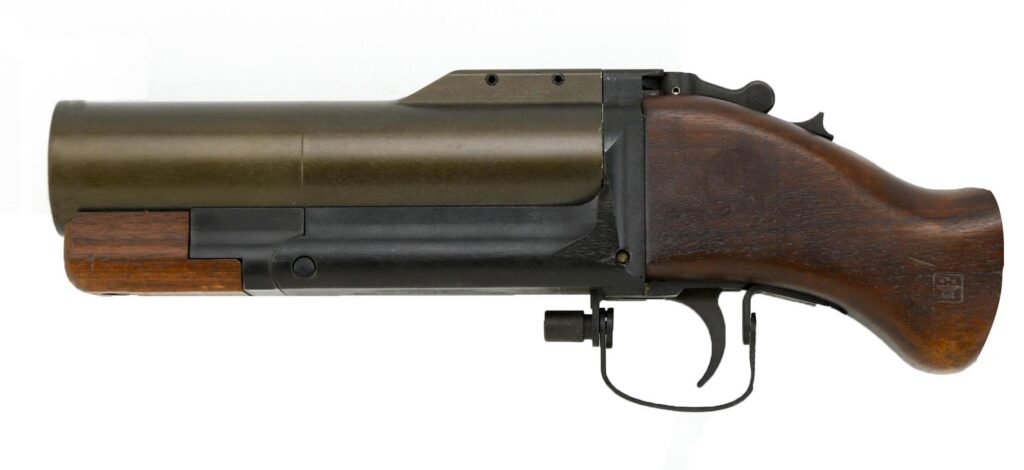
During 1953, the Project Niblick grenade launcher was under development at the Springfield Armory under the guidance of Cy Moore, with Dave Katz, a design engineer. The Picatinny Arsenal provided 40mm practice grenades for firing in the prototype launchers. There were three types of launchers being developed: a crude shoulder fired test fixture, a pistol and a three-shot semiautomatic launcher. The fixture was primarily a means of testing the ammunition to get an idea of the range and accuracy. The weight of the projectile was approximately 5.3 ounces. When launched with a quadrant elevation of 35 degrees, it had a range of 400 meters. Development commenced at the Springfield Armory. Proposed designs were identified by a letter “S” representing the Springfield Armory. Many of the designs never made it any further than the drawing board.
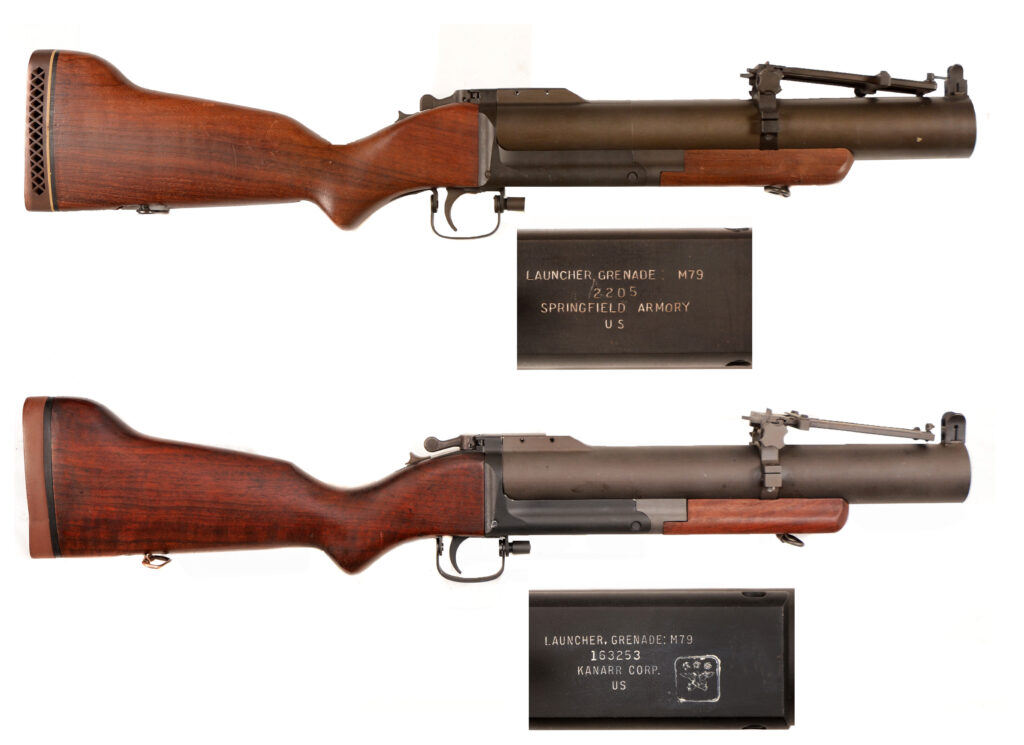
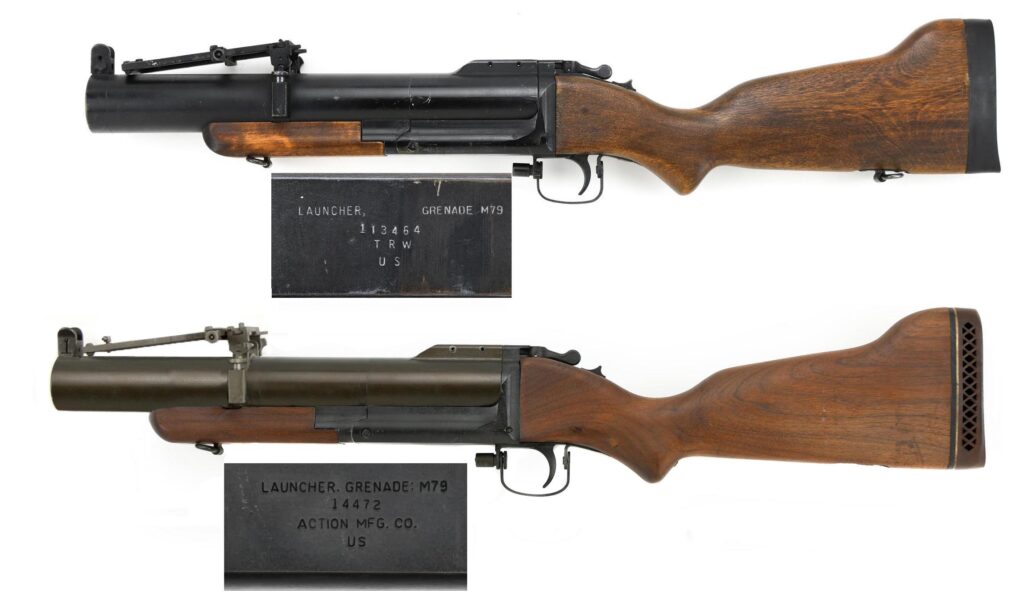
The Infantry Board at Fort Benning stated that they preferred a three-shot grenade launcher. A barrel length of 14 inches evolved as the length to make it unlikely that the gunner could get his fingers in front of the muzzle while firing. The three-shot launcher achieved semiautomatic operation through the use of a clip made up of three side-by-side chambers, each long enough to house a cartridge about 3.5 inches long. The clips would move to the left after firing by a constant force of a negator spring. As each round was fired, a latch detected the launching of the projectile and allowed the clip to move over until stopped by the next projectile, lining up that cartridge with the barrel. Although the basic concept was simple, the mechanism proved to be complex and unreliable. Continued misalignment between the projectile on the bore created gas leakage and a loss of accuracy. Special purpose rounds, such as CS gas or signal flares with a longer overall length, could not be used. The simplest design, designated as the “S-5,” was a single-shot, break-open type weapon. The S-5 evolved into the XM79 in 1959 after the three-shot S-6, T148E1 project was canceled.
After the idea of a multi-shot, semiautomatic launcher was scrapped, it was replaced by a simple, single-shot weapon, patterned after a break-open type shotgun. One launcher was ordered from Dave Mathewson, who operated a local fabrication shop, often used by the Springfield Armory. To keep the weight at a minimum, the weapon featured a hard-coated aluminum barrel. The odd shape of the stock was designed so that the bottom edge would be aligned with the line of recoil; the top or comb is contoured to keep the grenadier’s head upright owing to the line of sight relief when firing at low angles. To reduce the effects of the recoil on the shooter, a rubber recoil pad was fitted to the butt of the stock. The Infantry Board suggested a folding leaf sight mounted on the barrel with a bead front sight just above the muzzle. The XM79 launcher was sent to the Infantry Board in 1956 and was recommended for type classification in 1957.
To load the weapon, the operator simply moves the barrel-locking latch counter-clockwise to open the breech. Moving the release latch automatically puts the weapon into a safe position; opening the breech cocks the weapon. After closing the barrel, the safety must be pushed forward to fire. The weapon is easily field stripped by removing the front sling swivel screw and removing the forend. The barrel can then be disengaged from the fulcrum pin and separated from the receiver group.
The weight of the loaded launcher is 6.45 pounds; overall length is 28.78 inches. The stock and forearm are made of walnut. The rest of the weapon, except for the aluminum barrel, uses steel parts phosphated for corrosion protection. The original contract price for the M79 was $318.00 each. The M79 was issued with a small arms accessory case, which included a bore brush, plastic oil tube, combination tool and cleaning brush. Early carrying cases for the kit were made of canvas, later changed to vinyl.
During testing by the Infantry Board in June 1960, it was recommended that a new rear sight for the M79 launcher be designed and fabricated. The new sight was completed in October 1960. The early ladder-type sight was replaced with an adjustable, single crosspiece-type sight with a correction for azimuth. All launchers produced up to June 1960 had to be retrofitted. Confirmatory tests in December 1960 revealed requirements for additional windage adjustment on the rear sight. The additional sight modification was incorporated in the first production run. R&D continued in order to improve the reliability and function of the weapon. The launcher was considered acceptable by the Continental Army Command (CONARC) and was subsequently type-classified as the Launcher, Grenade, 40mm, M79 on December 15, 1960. By the first quarter of 1961, the new adjustable rear leaf sight was in full production, and several mandatory changes were implemented on the barrel locking lug, trigger spring and front sight.
The heat and humidity being experienced in Vietnam were causing problems with the warping and swelling of the wooden stocks of the M79. As a result, work began on designing a plastic buttstock and foregrip for the weapon. By 1964, a suitable plastic buttstock was available; General Tire was the primary contractor. There were no plastic foregrips adopted.
Although the M79 grenade launcher was designed and developed at the Springfield Armory, the majority were manufactured by civilian companies. Contracts awarded to private industry included: Action Manufacturing Company, Philadelphia, Pennsylvania, Contract DA-11-1199-ORD-736 and Exotic Metal Products, Pasadena, California, Contract DA-11-199-ORD-730. Other contracts were subsequently awarded to the Kanarr Corporation of Kingston, Pennsylvania, and Thompson Ramo Wooldridge (TRW) of Lyndhurst, Ohio. The decision to have private companies manufacture the M79, resulted in a lot of resentment with the civilian employees of the Springfield Armory. Series production ran from 1961 to 1971 with an estimated 350,000 M79 launchers produced.
Despite being replaced by modern grenade launchers, like the M320A1 and the M32A1, the M79 is still being fielded by the U.S. military.
The China Lake Grenade Launcher
Developed for the U.S. Navy SEAL teams was a limited production, pump-action 40mm grenade launcher, fed from an under-barrel tubular three-round magazine. The launcher was fitted with M79 front and rear sights and a shotgun-style stock. There was no official designation other than “The China Lake Grenade Launcher.” The weapon was developed at the Naval Weapons Center, China Lake, California, during 1967-1968.
The XM148 Grenade Launcher
While the adoption of the M79 grenade launcher solved one problem, it created another; it reduced the number of riflemen in a squad, the man carrying the single-shot M79 was usually armed with only a pistol for self-defense. To address the problem, the concept of the rifle-mounted launcher was studied. The 40mm XM148 launcher, first issued in 1967, was designed for mounting under the barrel of an M16 rifle. The weapon was developed by Colt Firearms to allow each rifleman in an infantry squad the ability to launch 40mm grenades, rather than one man equipped with an M79. During field testing in Vietnam, a number of problems were encountered. The XM148 launcher was not considered reliable or safe enough for type classification, and the launchers were pulled from service; most were destroyed.

The M203 Grenade Launcher
After the XM148 grenade launcher was scrapped, the concept of a rifle-mounted launcher was not. The Army initiated a competitive program for a new 40mm rifle-mounted grenade launcher. Designs were submitted by Aircraft Armaments Inc., Ford Aerospace and Communications Corporation and Aerojet Ordnance and Manufacturing Company. During August 1968, the Aircraft Armaments (AAI) design was type-classified as the XM203 grenade launcher. A small lot was manufactured and shipped to Vietnam for field testing. AAI’s XM203 40mm grenade launcher was found to be simple, safe and reliable. After successful testing and evaluation, the Aircraft Armaments design was type-classified as the Launcher, Grenade 40mm, M203 in 1969. Ironically, Aircraft Armaments, who developed the weapon, did not have the capacity to produce the number required by the Army, and a contract to manufacture the M203 was awarded to Colt Firearms. The U.S. M4 Carbine version of the M16 was adopted in 1994. The M203 launcher would not fit on the shorter M4. The M203 GL was modified into the M203A1, which is functionally the same as the M203 but is designed to fit on the M4 and M4A1 carbines. The quick-release M203A2 was designed for M4 carbines with a rail system and with M16A4 rifles that have the M5 adapter rail. Currently, there are at least seven U.S. companies manufacturing the M203 grenade launchers and its variants.

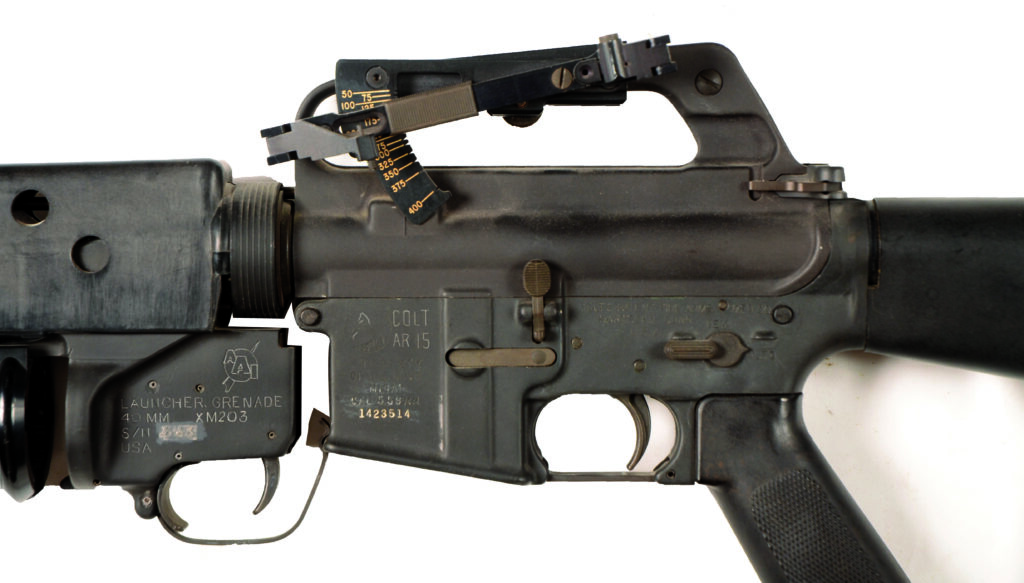
The M320 Grenade Launcher
During 2004, the U.S. Army issued a requirement for a new technically advanced grenade launcher with improved accuracy, ergonomics, safety and function as a stand-alone weapon. Development of the XM320 single-shot launcher, based on the HK AG36, began at the Picatinny Arsenal. The 40mm M320, which can also be attached under the barrel of a host weapon, was adopted in 2016 to replace the M203 under-barrel launcher.
The M32A1 Multi-Shot Grenade Launcher
While fighting in Iraq, the U.S. Marines requested a grenade launcher with a rapid rate of fire. An off-the-shelf, multi-shot revolver type, semiautomatic launcher was submitted by Milkor USA based in Arizona. The weapon was tested in 2006 and was eventually adopted by the U.S. Marine Corps as the M32A1 Multi-shot Grenade Launcher, and by the USSOCOM as the Mk 14 Mod 0.
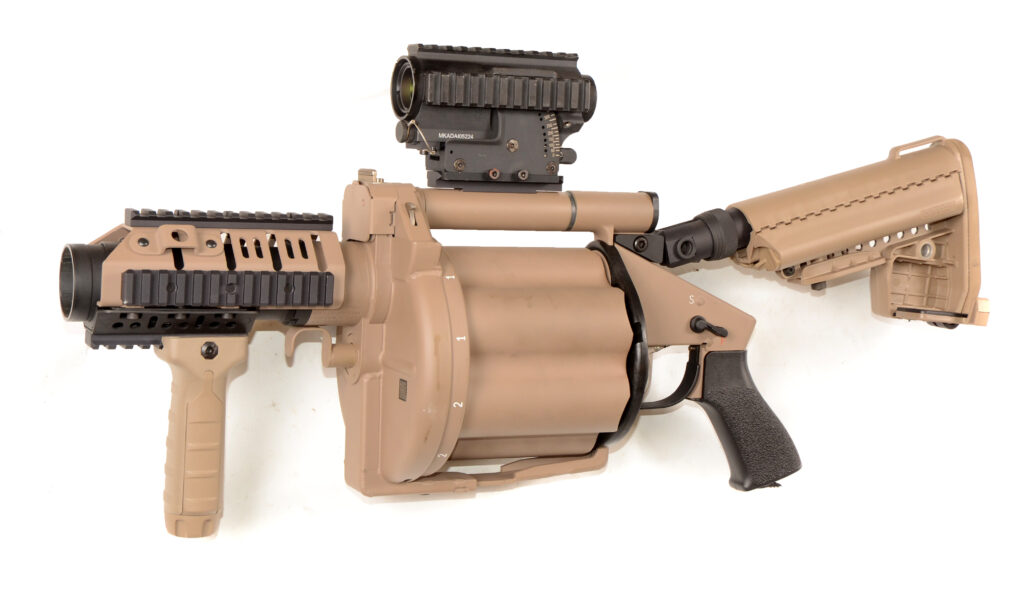
| This article first appeared in Small Arms Review V24N9 (November 2020) |



